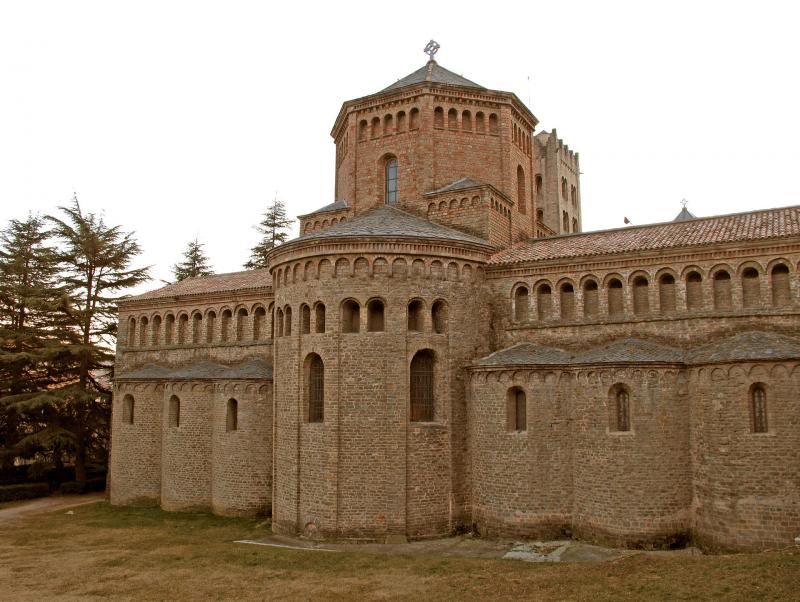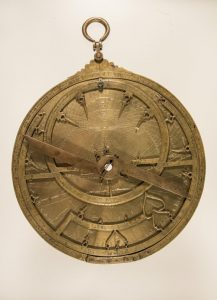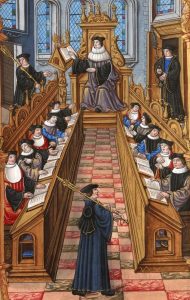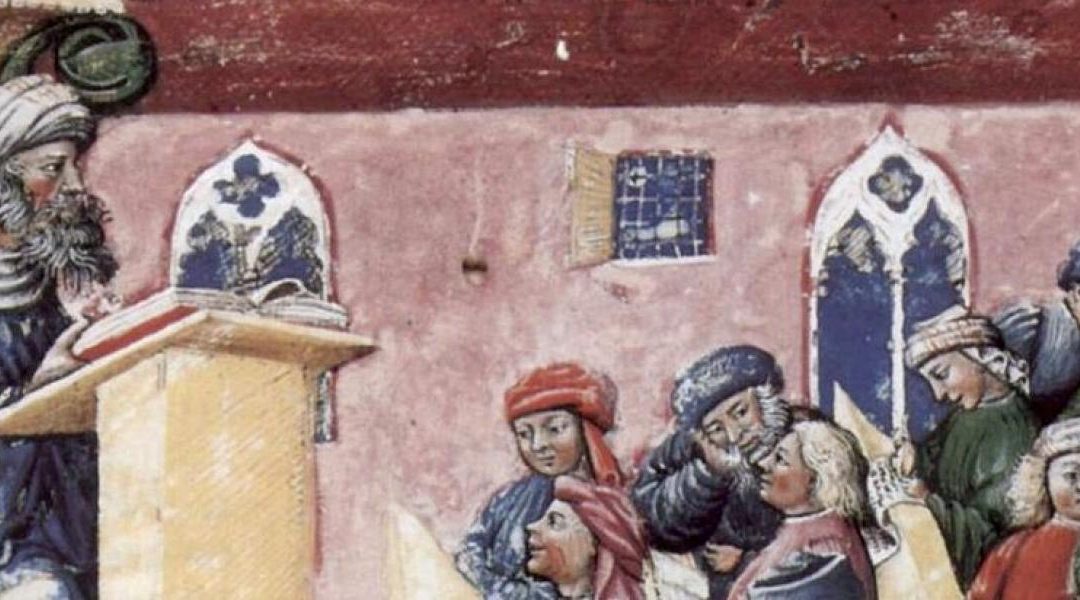—The spaces where knowledge was preserved, debated and developed in the Middle Ages.—
After the disintegration of the Roman educational system, in the Middle Ages, three phases characterising the development of educational institutions in the Latin world overlap: monastic schools (the sixth to the ninth century), urban schools (the eleventh century) and universities (the twelfth to the fifteenth century). Before the eleventh century, monastic houses, small isolated premises, founded on the Benedictine rule, became authentic centres of knowledge conservation thanks to their scriptoria and libraries. The monasteries had an absolute monopoly on education in Europe. Families who sought to consecrate their children to religious life took them to these residential schools. In these schools, reading and learning was individual, contemplative and silent. However, those families who wanted social advancement for their children took them to the monastic day schools. These schools, joined by the cathedral schools, trained the members of the secular clergy among other groups. With the growth of cities, the latter would eclipse the monastic ones from the eleventh century on.
The attempt made by Charlemagne (786-814) to more systematically promote teaching throughout his vast empire and to encourage the creation of monastic schools and cathedrals, in parallel with his administrative reforms, contributed to this phenomenon in the Frankish world. Charlemagne’s institutional initiatives raised the level of scientific discourse, expanded libraries and promoted access to botanical species that were difficult to find, among other important achievements. The supply of texts studied was scarce and came from late Antiquity. Useful elements of Roman secular education were incorporated, from grammar to elementary mathematics, and new treatises on natural philosophy, mathematics and medicine would gradually be introduced. Monasteries such as Bobbio (northern Italy), Fulda (western Germany) or Saint Gall (northern Switzerland) maintained contact with each other and exchanged knowledge. A network of visits was established among those that allowed books to be borrowed, medical prescriptions to be exchanged and seeds of medicinal plants to be transferred to other locations. Furthermore, these contacts encouraged the copying of manuscripts in the scriptoria, which expanded monastic libraries with religious and secular books, while creating medicinal gardens with native and exotic plants.

Apse of the Benedictine monastery of Santa Maria de Ripoll (Catalonia). Wikipedia.
In this bustling world, redeveloped since the eleventh century, some schools flourished. Organised around a charismatic teacher, a group of students was trained in a set of knowledge that often depended on the specific training of the teacher. Such was the case of the master of Reims, Gerbert of Aurillac. After learning about Arab mathematics and astronomy in Catalonia and importing scientific objects such as the armillary sphere, the abacus or the astrolabe, along with the texts of the quadrivium, he established a famous school that attracted students from far and wide. Other schools, such as Monte Casino would achieve extraordinary fame, particularly for its great translation work and access to numerous texts of a medical nature, translated by the monk Constantine the African. These texts remained fundamental in universities until the sixteenth century.

Plan of the Benedictine monastery of Saint Gall, Library of the Abbey of St Galll, Codex Sangallensis 1092, (ca. 825, Switzerland). Wikipedia.
During the twelfth century, there was a major recovery of Latin texts on ancient jurisprudence, history, science, medicine, and philosophy through a process of translation from Greek and Arabic. This fundamental body of knowledge was communicated through a new institution: the Studium Generale or university. From the foundation of the oldest in Bolonia and Paris in the twelfth century, the creation of these centres was incessant throughout the European area. In 1378 there were about thirty. In all states and in the most important cities, there was concern about having a place, which was considered to be central motor of social progress, understood not in a democratic sense but from the prevailing feudalism. It is impossible to study the evolution of scientific thought without taking into account what was the most genuine and opportune of the institutions and achievements of the Middle Ages, considering its duration and how widespread it was as a model of higher education throughout the world. However, we must understand the term ‘university’ in the sense of its legal corporate status, which gave control over the teaching and certification of its members.
Such a process would not have been possible without the dissemination of law (civil and canonical). This led to the organisation of medieval institutions in corporations or guilds (communio, societas or universitas), a situation that extended to urban government and to the organisation of work and business. This same model of corporate development, identical to that of many medieval institutions, was key to the expansion of knowledge in medieval Europe with regard to teaching. Indeed, teachers and students, organised in small communities, adopted this path to establish the future university model. Local circumstances varied, but in all cases it was possible to organise the curriculum, exams or grades in a certain way, triggering an expanding model throughout the European West. Near all the pioneering centres (Paris, Oxford or Bolonia) there were highly reputable teachers who created an environment conducive to the creation of schools. These ancient centres relinquished their importance to the growing university.

Astrolabe of al-Sahlî, Museo Arqueológico Nacional (Madrid) (1067, Toledo). Wikipedia.
Before reaching university, however, it was necessary to have basic training which could be acquired in several ways. On the one hand, there were private teachers, who were the privilege of the aristocracy. On the other hand, for the majority, grammar schools were created, spread throughout the European West, even in rural areas. Here future solicitors, clerks or secretaries of municipalities and foreign ministries were trained as they did not need to be trained at university. They were attended by more and more of the children of merchants, artisans and even wealthy farmers who saw in education an instrument for professional and personal promotion.
During the twelfth and thirteenth centuries, universities acquired some particular features. First, they were designed to provide the study of subjects that were especially useful for society. Second, they became legally recognised corporations, with rights and responsibilities detailed in cartularies and documents. Lastly, they established a fixed curriculum, which allowed an academic degree to be obtained.

Meeting of doctors at the University of Paris. Étienne Colaud, Bibliothèque Nationale de France (14th century, Paris). Wikipedia.
From its beginning, the universitas designated a group of students and teachers who lived there for the purpose of training. Both students and teachers came from far and wide, but they managed to bring together a group of teachers of proven worth, specialists in the disciplines offered, with those who wanted to avidly learn specific knowledge. Students started at about fourteen or fifteen and ended at around twenty. However, their circumstances were very variable; some barely lasted a year or left their studies and returned later. These students, due to their diverse origins, were organised into nations, nuclei, from which bonds of solidarity were maintained and institutional influence was exercised. Soon collegia also appeared as houses that allowed students to be accommodated, but also carried out pedagogical tasks and provided books, given that universities did not have their own libraries, and covered other student needs. The training received allowed students to later teach at any other university.
Universities were organised into faculties, usually divided into arts, theology, law and medicine. Not all universities had all four. Some centres specialised in law or medicine, and the arts were also seen as preparatory teaching for medicine, which led them to be associated. The university structure channelled an enormous flow from natural philosophy, logic and mathematics to the more important faculties. Those who advanced to the faculties of theology and medicine had significant training in natural philosophy, which they continued to use. In reality, the arts faculties provided the analytical techniques and conceptual tools for the more important faculties. Not even Bible lessons remained immune to these teachings on scientific knowledge, which were applied in great detail to interpret the biblical passages. The same was true of medicine, since mathematics, astronomy and medical astrology were traditionally part of the studies of future physicians. In fact, medicine became precisely a scientia when it was founded on natural philosophy, thus transcending mere mechanical work.

Liber ethicorum des Henricus de Alemannia (classroom with students), Laurentius de Votolina (14th century, Bologna). Wikimedia.
The functions of the medieval university can only be understood within scholasticism, which became the only pedagogical tool. The central focus of this method was placed on the texts of the authorities, whether legal, medical, philosophical or theological, and submitted them to reading and discussion (lectio, questio and disputatio). Students learned by listening to the materials discussed and the arguments that repeatedly analysed them from different angles. The University proved to be an institution with remarkable resilience to war, epidemics, hunger, and personal and intellectual disputes for centuries.
Carmel Ferragud
IILP-UV
How to cite this paper:
Ferragud, Carmel. Monasteries and universities. Sabers en acció, 2020-11-18. https://sabersenaccio.iec.cat/en/monasteries-and-universities/.
Find out more
You can find further information with the bibliography and available resources.
Recommended reading
Lindberg, David C. Los inicios de la ciencia Occidental. La tradición científica europea en el contexto filosófico, religioso e institucional (desde el 600 a.C. hasta 1450). Barcelona-Buenos Aires-México: Paidós; 2002.
Studies
Cifuentes, L. La ciència en català a l’edat mitjana i el Renaixement. Barcelona-Palma de Mallorca: Universitat de Barcelona-Universitat de les Illes Balears; 2006. 2 ed.
Cruselles, José M. Escuela y sociedad en la Valencia bajomedieval. Valencia: Diputación de Valencia; 1997.
Pedersen, Olaf. The First Universities: Studium Generale and the Origins of University Education in Europe. Cambridge: Cambridge University Press; 1997.
Ridder-Symoens, Hilde. Historia de la Universidad en Europa. Vol. I: Las Universidades en la Edad Media. Bilbao: Universidad del País Vasco; 1995.
Shank, Michael H. Schools and Universities in Medieval Latin Science. In: Lindberg, David C.; Shank, Michael H. The Cambridge history of Science. Vol. 2: Medieval Science. New York: Cambridge University Press; 2013, p. 207-239.
Sources
Beltran of Heredia, Vincent. Cartulario de la universidad de Salamanca (1218-1600). Vols. I y II. Salamanca: Universidad de Salamanca; 1971.
Soldevila, Ferran, ed. Butla fundacional de la Universitat de València. 1501. Valencia: Universitat de València; 2001.
VVAA. Llibre de les Constitucions i Estatuts de l’Estudi General de Lleida. Lleida: Universitat de Lleida; 2000.
Websites and other resources
Sciència.cat DB Base de datos de la ciencia y la técnica en catalán en la Edad Media y el Renacimiento. Available here.



